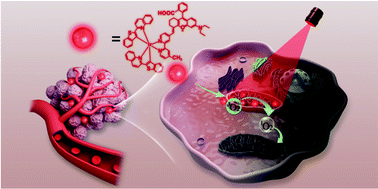A new near-infrared phosphorescent iridium(iii) complex conjugated to a xanthene dye for mitochondria-targeted photodynamic therapy†
Abstract
Iridium(III) complexes are potent candidates for photodynamic therapy (PDT), but some key drawbacks still hamper clinical translation, such as poor operability in the phototherapeutic window, high dark toxicity, and low reactive oxygen species (ROS) production efficiency. In this work, a near-infrared phosphorescent Ir(III) complex conjugated to a xanthene dye, NIR-Ir-XE, is reported with highly favourable properties for mitochondria-targeted imaging and cancer phototherapy. The generation of the triplet excited state of a xanthene moiety endows the NIR-Ir-XE to form singlet oxygen (1O2) for use as a photodynamic therapy agent after irradiation with visible light. Compared with the xanthene-free Ir(III) counterpart (NIR-Ir-bpy), the xanthene-modified cyclometalated Ir(III) photosensitizer NIR-Ir-XE exhibits higher 1O2 generation efficiency, negligible dark toxicity and a better therapeutic effect. Importantly, a clear correlation between cell death and intracellular generation of 1O2 derived from NIR-Ir-XE after light irradiation was demonstrated. The corresponding in vivo photo-antitumor performance was further demonstrated to be effective in tumor-bearing mice. The observed properties of NIR-Ir-XE qualify it as a promising PDT agent.



 Please wait while we load your content...
Please wait while we load your content...